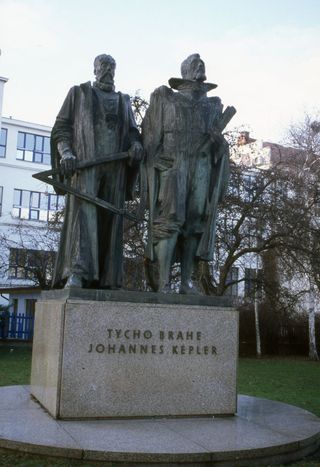Johannes Kepler: Everything you need to know
The early-17th-century astronomer Johannes Kepler defined the basic rules governing planetary motion.

The basis for everything we understand about the orbits of the planets comes from the work of German astronomer Johannes Kepler
Kepler, without knowing about the force of gravity, mathematically described the motions of the planets around the sun in his three laws of planetary motion. His work was key in providing evidence for Nicolaus Copernicus' theory that the sun, not Earth, was at the center of the solar system.
Related: Kepler's Third Law: The movement of solar system planets
When was Kepler born?
Johannes Kepler was born on Dec. 27, 1571, in the Free Imperial City of Weil der Stadt, which today is near Stuttgart, Germany. He was abandoned by his soldier father at a young age and was raised as a Lutheran by his mother and grandparents.
Though neglected as a child, he displayed a knack for mathematics and witnessed two astronomical events that spurred his interest in the cosmos: the Great Comet of 1577 and a total lunar eclipse in 1580. However, a bout of smallpox left Kepler with crippled hands and damaged eyesight.
As a teenager, Kepler studied at a Cistercian monastery in Adelberg, where he learned Latin, the language used by the scholars of the day, thus setting him up for his academic studies as an adult. He progressed on to the University of Tübingen in Germany, where he studied philosophy.
Kepler, Copernicus and the platonic solids
While at Tübingen, Kepler's math professor, Michael Maestlin, introduced him to Copernicanism, named after Copernicus, who had died in 1543. This heliocentric, or Sun-centered, model describes how Earth and other planets in the solar system orbit the sun, and not the other way around.
In the late 16th century, heliocentrism was still a fringe theory; most people believed Earth was at the center of creation. At Tübingen, Kepler was taught both theories, and upon reading Copernicus' "De revolutionibus orbium coelestium libri vi" ("Six Books Concerning the Revolutions of the Heavenly Orbs"), he immediately dismissed the geocentric, or Earth-centered, theory in favor of the heliocentric model.
Although heliocentrism made logical sense, observational evidence for the model was missing in the late 16th century. Kepler made it his life's mission to provide that evidence; he saw it as a way to better grasp God's grand design. In the devout times in which Kepler lived, even appeals to logic required divine explanation.
In 1594, Kepler took a post teaching math and astronomy in Graz, Austria, where he had a breakthrough. While playing with geometric shapes on a chalkboard, Kepler drew a circle inside an equilateral triangle, with the circle touching the triangle halfway down each side. He then drew another circle around the triangle, with the circle touching the triangle at each of its three points.
Kepler believed that the ratio of the size of the circles matched the ratio of the orbits of Jupiter and Saturn, and imagined that between each planet's orbit was a "platonic solid" — a three-dimensional polyhedron. Kepler interpreted this as part of God's underlying geometric design supporting the orbits of the planets. In 1596, he published his ideas in his book "Mysterium Cosmographicum."
Kepler also worked on some other ideas that would be deemed wacky today. For example, in 1619, he published "Harmonices Mundi," in which he argued that the motion of the six known planets (before the discovery of Uranus and Neptune) could be described by musical tones and that their orbits produced harmonies. Despite these bizarre ideas, Kepler modeled the planets' orbits more precisely than anyone before him.
Did Kepler kill Tycho Brahe?

In 1600, Kepler traveled to Benatky Castle, near Prague, to work as an observing assistant to Danish astronomers Tycho Brahe and Christen Sørensen Longomontanus. With Longomontanus, Kepler carefully tracked the motion of Mars through the sky, mapping its orbit. Kepler noticed that the farther Mars was from the sun, the more slowly the planet moved, and the closer it was to the sun, the faster Mars moved along its orbit.
Those were Kepler's first steps in providing observational evidence for the heliocentric model. However, Kepler was not happy working for Brahe and Longomontanus. For one thing, his superiors were geocentrists and dismissed Kepler's Copernicanism. Second, Brahe did not allow Kepler to access records of his own detailed observations of the heavens made across decades.
Third, the environment at Benatky Castle was raucous, with lots of partying, alcohol and music, and little privacy; Brahe, in particular, was a party animal. Kepler issued a set of demands, asking for a more formal contract and better working conditions, but he was promptly thrown out of the castle. Fortunately, wiser heads prevailed, Brahe and Kepler made up, and Kepler returned with his family in tow.
However, in 1601, there was a huge plot twist: After a period of particularly heavy partying, Brahe died. At the time, his death was blamed on a kidney stone, but in the 1990s, it was suggested that Brahe could died from mercury poisoning, with Kepler a suspect in Brahe's death. However, in 2010, Brahe's remains were exhumed, and a toxicology report found no evidence of mercury poisoning. Instead, it is thought that Tycho died from a bacterial infection, prostate cancer or a burst bladder.
When did Kepler die?
Kepler died from a fever, possibly the result of a bladder infection, on Nov. 15, 1630, at age 58, in Regensburg, Germany.
However, his name forever lives on, in both his laws of planetary motion and NASA's Kepler space telescope, which discovered thousands of exoplanets between 2009 and 2018.
Kepler's three laws of planetary motion

Upon Tycho's death, Kepler replaced him as the Imperial Mathematician to the Holy Roman Emperor, Archduke Ferdinand. On his deathbed, Brahe had permitted Kepler to use his preciously guarded astronomical data, and these data proved vital in the work that Kepler is best known for: his three laws of planetary motion.
In 1609, Kepler published "Astronomia Nova," which detailed his 10-year-long study of the motion of Mars in the sky. "Astronomia Nova" contained the first two laws; the third law was published in "Harmonices Mundi." Then, in 1621, Kepler published his magnum opus, "Epitome Astronomiae," which described all three laws in full.
Remarkably, without knowledge of the force of gravity that governs the orbits of the planets, Kepler had provided the basic mathematics of orbital motion. They were later developed further by Isaac Newton, who is credited with "discovering" gravity, and Kepler's laws were fundamental to Newton's laws of gravitation.
The laws of planetary motion were not the only valid scientific work conducted by Kepler. In 1604, he published "Astronomiae Pars Optica" ("The Optical Part of Astronomy"), which explained why the lunar eclipse he had seen in 1580 was red (the result of atmospheric refraction of sunlight). In 1604, he witnessed a supernova in the constellation Ophiuchus, the serpent bearer, which was the last supernova seen in the Milky Way.
After the invention of the telescope in 1608, Kepler experimented with telescopic optics, improving upon the designs of Hans Lippershey and Galileo Galilei to create the Keplerian telescope, which formed the basis of all modern refracting telescopes.
What is the first law of planetary motion?
The first law of planetary motion states that planets move in slightly elliptical orbits — subtle ovals rather than circles. Furthermore, it states that the sun is located at one focus of the ellipse. With a circle, there is a center that is equidistant from all points on that circle. In contrast, an ellipse does not have a center that is equidistant. Instead, an ellipse has two foci — one on each side of the center — along the center line linking the two widest parts of the ellipse. (This is called the semimajor axis.) The sun is at one of these foci.
What is the second law of planetary motion?
The second law of planetary motion relates to how a planet orbits more slowly the farther it is from the sun on its elliptical orbit. It states that if you were to draw a line between a planet and the sun, this line would sweep out equal areas during equal amounts of time.
To understand this idea, picture an ellipse with the sun at one focus, as described in the first law, and draw an imaginary line from the sun to a planet on that ellipse. Now, imagine the planet moving along its elliptical orbit for a given amount of time when it is at the opposite side of the ellipse as the sun. Because it is farther from the sun, it's moving more slowly. The line between the planet and the sun will make an angle covering a certain area of the ellipse. Now, picture the planet on the other side of the ellipse, closest to the sun, moving for the same amount of time. Here, it is moving faster, and the angle it draws is larger. But because it is closer to the sun, it covers the same total area.
What is the third law of planetary motion?
The third law of planetary motion states that the square of a planet's orbital period is proportional to the cube of the length of the semimajor axis of its orbit. This is a complex way of saying that the amount of time it takes for a planet to complete one orbit around the sun (i.e., its orbital period) is proportional to the semimajor axis of its elliptical orbit, which is the line that cuts through the center of the ellipse and connects the two widest parts. A planet with a larger semimajor axis will take longer to orbit the sun. In other words, Venus takes longer to orbit the sun than Mercury does, Earth takes longer than Venus, Mars takes longer than Earth, and so on.
Johannes Kepler FAQs
What is Kepler best known for?
Johannes Kepler was an astronomer best known for his three laws of planetary motion, which describe how the planets move in ellipses around the sun. His name is also well-known thanks to NASA's exoplanet-finding Kepler space telescope.
What did Kepler invent?
In 1611, Kepler invented a type of telescope, now called a Keplerian telescope, that used a convex eyepiece lens to provide a wide field of view, rather than the narrow field seen through Galileo's concave-lens telescope. The Keplerian design became the basis for all future refracting telescopes
How old was Kepler when he died?
Kepler was 58, six weeks shy of his 59th birthday, when he died from a brief illness in 1530 while on a trip to Regensburg, Germany.
Additional resources
Check out this neat video from NASA describing Kepler's laws of planetary motion. You can also learn about the NASA exoplanet-hunting space telescope that was named after Kepler. Discover more about the supernova that Johannes Kepler witnessed in 1604 at NASA's website.
Bibliography
University of Hawaii Institute of Astronomy Lecture 7: Laws of Planetary Motion, https://home.ifa.hawaii.edu/users/joseph/7.Kepler.pdf
Francesco Barreca, The Correspondence of Johannes Kepler, http://emlo-portal.bodleian.ox.ac.uk/collections/?catalogue=johannes-kepler
The History of Johannes Kepler, NASA JPL, 2004, https://www.jpl.nasa.gov/news/the-history-of-johannes-kepler
Stanford Encyclopedia of Philosophy, 2021, https://plato.stanford.edu/entries/kepler/
Robert S. Westman, Encyclopaedia Britannica, 2023, https://www.britannica.com/biography/Johannes-Kepler
J. L. Heilbron, Encyclopaedia Britannica, 2023 https://www.britannica.com/science/Platonic-solid
Michael Lucibella, APS News, This Month in Physics History, July 19, 1595: Kepler's Insight Leading to Mysterium Cosmographicum, 2014 https://www.aps.org/publications/apsnews/201407/physicshistory.cfm
Kepler's Harmonices Mundi, University College Oxford, 2014 https://www.univ.ox.ac.uk/news/keplers-harmonices-mundi/
Owen Gingerich and James R. Voelkel, Tycho and Kepler: Solid Myth versus Subtle Truth, Social Research, Vol 72 No. 1, pp77–106, https://www.jstor.org/stable/40972003
Martina Redpath, Tycho Brahe: Party Animal and Astronomer! Armagh Observatory and Planetarium, 2012, https://armaghplanet.com/tycho-brahe-party-animal-and-astronomer.html
Mercury poisoning ruled out as cause of Tycho Brahe's death, Aarhus University, 2012, https://projekter.au.dk/en/tycho-brahe/pressreleases/mercury-poisoning-ruled-out-as-cause-of-tycho-brahes-death
Jack Lissauer, In Retrospect: Kepler's Astronomia Nova, Nature, 462, 725, 2009, https://www.nature.com/articles/462725a
The Sun, the orb of the Earth and the sphere of the fixed stars (M.12.40), University of Cambridge Digital Library, https://cudl.lib.cam.ac.uk/view/PR-M-00012-00040-00006/1
Gloria Hon and Yaakov Zik, Kepler's Optical Part of Astronomy (1604): Introducing the Ecliptic Instrument, Perspectives on Science, Vol 17 No. 3, 2009, https://direct.mit.edu/posc/article/17/3/307/15252/Kepler-s-Optical-Part-of-Astronomy-1604
NASA, Kepler's Supernova Remnant: Debris from Stellar Explosion Not Slowed After 400 Years, 2020 https://www.nasa.gov/image-article/keplers-supernova-remnant-debris-from-stellar-explosion-not-slowed-after-400-years/
Encyclopaedia Britannica, 2019, https://www.britannica.com/science/Keplerian-telescope
Encyclopaedia Britannica, https://www.britannica.com/question/How-and-where-did-Johannes-Kepler-die
Join our Space Forums to keep talking space on the latest missions, night sky and more! And if you have a news tip, correction or comment, let us know at: community@space.com.
Get the Space.com Newsletter
Breaking space news, the latest updates on rocket launches, skywatching events and more!

Keith Cooper is a freelance science journalist and editor in the United Kingdom, and has a degree in physics and astrophysics from the University of Manchester. He's the author of "The Contact Paradox: Challenging Our Assumptions in the Search for Extraterrestrial Intelligence" (Bloomsbury Sigma, 2020) and has written articles on astronomy, space, physics and astrobiology for a multitude of magazines and websites.
-
mcswell "Kepler noticed that the farther Mars was from the sun, the more slowly the planet moved, and the closer it was to the sun, the faster Mars moved along its orbit.Reply
...
Brahe and Longomontanus... were geocentrists and dismissed Kepler's Copernicanism."
Assuming that "closer to the Sun" means physically closer in its orbit, not visually closer as seen from Earth. Hence Kepler's observation presupposes the heliocentric theory.
1) How did he measure the distance of Mars from the Sun?
2) Since Brahe and Longomontanus were geocentrists, presumably they did not buy into Kepler's observation, correct? -
Questioner Yeah he/one would need to conceptualize the Earth as a moving/orbiting platform/observation-point, itself orbiting the Sun.Reply
All measures and movements would be relative to that.
That would be a lot to piece together into a composit whole.
Sounds pretty remarkable to me. -
Helio Reply
This also happens with the use of epicycles and Ptolemy’s equant. Kepler was well aware of this. The problem was that this model only came close to accuracy, which is why new planetary tables had to be produced.mcswell said:"Kepler noticed that the farther Mars was from the sun, the more slowly the planet moved, and the closer it was to the sun, the faster Mars moved along its orbit.
Tycho was convinced he could falsify the Ptolemy model by using the relative distances to Mars. Many of Tycho’s measurements were accurate to 1/2 arc min — 2x better than the eye can see.
Kepler knew he had the basis to produce an improved model — Tycho’s data for Mars.
This high confidence in Tycho carried Kepler for years in doing his heavy math calculations involving hundreds of pages of calculations.
He didn’t, AFAIK. The transit of Venus gave us that, though there were many reasonable other approaches.mcswell said:1) How did he measure the distance of Mars from the Sun?
I’m guessing Tycho, at least, had died before Kepler conducted measurements. I also think that Kepler’s observations were useful only after sneaking a telescope from Galileo, via a friend.mcswell said:2) Since Brahe and Longomontanus were geocentrists, presumably they did not buy into Kepler's observation, correct? -
Classical Motion Kepler and all others have not noticed the Z motion. A planetary orbit is made from two rotations. Two angular accelerations. The first rotation is small, and it's pulled and stretched out.....into a larger rotation. A rotation inside of a rotation. One open rotation which forms a closed rotation. A one turn closed helix.Reply
And until science can explain those rotations, we will never know the true dynamic of gravity.
This dynamic was finally revealed when catching a moon trajectory, and traced thru a debris field. And know one has noticed it, even today.
All intellect is surrendered for space time. An institutional science.
